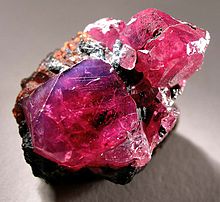
Rubies of various sizes have been found throughout the world. This is a list of rubies by size.

Rubies of various sizes have been found throughout the world. This is a list of rubies by size.
A ruby is a pink to blood-red colored gemstone, a variety of the mineral corundum (aluminium oxide). Other varieties of gem-quality corundum are called sapphires. Ruby is one of the traditional cardinal gems, together with amethyst, sapphire, emerald, and diamond. [1] The word ruby comes from ruber, Latin for red. The color of a ruby is due to the element chromium.
Some gemstones that are popularly or historically called rubies, such as the Black Prince's Ruby in the British Imperial State Crown, are actually spinels. These were once known as "Balas rubies".
The quality of a ruby is determined by its color, cut, and clarity, which, along with carat weight, affect its value. The brightest and most valuable shade of red called blood-red or pigeon blood, commands a large premium over other rubies of similar quality. After color follows clarity: similar to diamonds, a clear stone will command a premium, but a ruby without any needle-like rutile inclusions may indicate that the stone has been treated. Ruby is the traditional birthstone for July and is usually pinker than garnet, although some rhodolite garnets have a similar pinkish hue to most rubies. The world's most valuable ruby is the Sunrise Ruby.
| Name | Origin | Date | Uncut size | Cut size | Location | Ref |
|---|---|---|---|---|---|---|
| Maharlika Star Ruby | India | 10,820 carats (2,164 g) | Philippines | |||
| Liberty Bell Ruby | Burma | 1976 [lower-alpha 1] | 8,500 carats (1,700 g) | Stolen and still missing | [2] | |
| Neelanjali Ruby | 1,370 carats (274 g) | |||||
| Prince of Burma | Burma | 1996 | 950 carats (190 g) | |||
| Rosser Reeves Ruby | Sri Lanka | 138.7 carats (27.74 g) | National Museum of Natural History | [3] | ||
| DeLong Star Ruby | Burma | 1930 | 100.32 carats (20.064 g) | American Museum of Natural History | [4] | |
| Garrard's Red Ruby | Burma | 40.63 carats (8.126 g) | [5] | |||
| Sunrise Ruby | 25.59 carats (5.118 g) | [6] | ||||
| Carmen Lúcia Ruby | Burma | 1930s | 23.1 carats (4.62 g) | National Museum of Natural History | [7] | |
| Elizabeth Taylor Ruby | 8.243 carats (1.6486 g) | [8] | ||||
| Hell’s Embargo Ruby | Burma | 2021 | 4,794 carats (958.8 g) | Annies Gems | ||
| Seraphine Ruby | Burma | 2022 | 5.03 carats | Gems of Note | ||
| Star of Fura | Mozambique | 2022 | 55.22 carats | [9] |
Notes
References
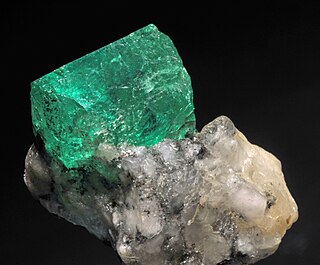
Emerald is a gemstone and a variety of the mineral beryl (Be3Al2(SiO3)6) colored green by trace amounts of chromium or sometimes vanadium. Beryl has a hardness of 7.5–8 on the Mohs scale. Most emeralds have much material trapped inside during the gem's formation, so their toughness (resistance to breakage) is classified as generally poor. Emerald is a cyclosilicate.

A gemstone is a piece of mineral crystal which, when cut or polished, is used to make jewelry or other adornments. Certain rocks and occasionally organic materials that are not minerals may also be used for jewelry and are therefore often considered to be gemstones as well. Most gemstones are hard, but some softer minerals such as brazilianite may be used in jewelry because of their color or luster or other physical properties that have aesthetic value. However, generally speaking, soft minerals are not typically used as gemstones by virtue of their brittleness and lack of durability.
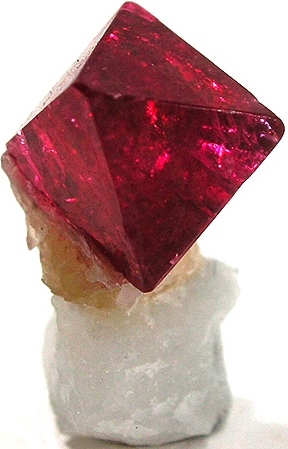
Spinel is the magnesium/aluminium member of the larger spinel group of minerals. It has the formula MgAl
2O
4 in the cubic crystal system. Its name comes from the Latin word spinella, a diminutive form of spine, in reference to its pointed crystals.

Sapphire is a precious gemstone, a variety of the mineral corundum, consisting of aluminium oxide (α-Al2O3) with trace amounts of elements such as iron, titanium, cobalt, lead, chromium, vanadium, magnesium, boron, and silicon. The name sapphire is derived via the Latin sapphirus from the Greek sappheiros (σάπφειρος), which referred to lapis lazuli. It is typically blue, but natural "fancy" sapphires also occur in yellow, purple, orange, and green colors; "parti sapphires" show two or more colors. Red corundum stones also occur, but are called rubies rather than sapphires. Pink-colored corundum may be classified either as ruby or sapphire depending on locale. Commonly, natural sapphires are cut and polished into gemstones and worn in jewelry. They also may be created synthetically in laboratories for industrial or decorative purposes in large crystal boules. Because of the remarkable hardness of sapphires – 9 on the Mohs scale (the third hardest mineral, after diamond at 10 and moissanite at 9.5) – sapphires are also used in some non-ornamental applications, such as infrared optical components, high-durability windows, wristwatch crystals and movement bearings, and very thin electronic wafers, which are used as the insulating substrates of special-purpose solid-state electronics such as integrated circuits and GaN-based blue LEDs. Sapphire is the birthstone for September and the gem of the 45th anniversary. A sapphire jubilee occurs after 65 years.

A ruby is a pinkish red to blood-red colored gemstone, a variety of the mineral corundum. Ruby is one of the most popular traditional jewelry gems and is very durable. Other varieties of gem-quality corundum are called sapphires. Ruby is one of the traditional cardinal gems, alongside amethyst, sapphire, emerald, and diamond. The word ruby comes from ruber, Latin for red. The color of a ruby is due to the element chromium.

Cuprite is an oxide mineral composed of copper(I) oxide Cu2O, and is a minor ore of copper.
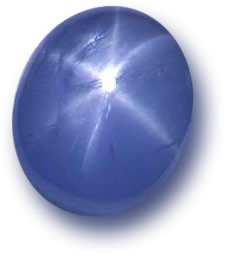
An asterism is a star-shaped concentration of light reflected or refracted from a gemstone. It can appear when a suitable stone is cut en cabochon.

Tsavorite or tsavolite is a variety of the garnet group species grossular, a calcium-aluminium garnet with the formula Ca3Al2Si3O12. Trace amounts of vanadium or chromium provide the green color.

The Gemological Institute of America (GIA) is a nonprofit institute based in Carlsbad, California. It is dedicated to research and education in the field of gemology and the jewelry arts. Founded in 1931, GIA's mission is to protect buyers and sellers of gemstones by setting and maintaining the standards used to evaluate gemstone quality. The institute does so through research, gem identification, diamond grading services, and a variety of educational programs. Through its library and subject experts, GIA acts as a resource of gem and jewelry information for the trade, the public and media outlets.
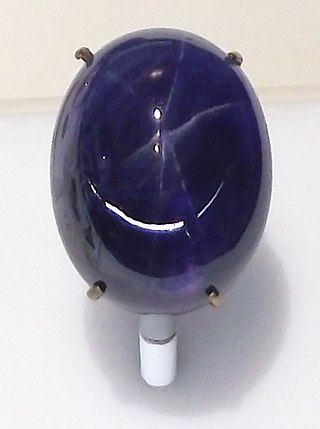
The Star of Bombay is a 182-carat (36.4-g) cabochon-cut star sapphire originating in Sri Lanka. The violet-blue gem was given to silent film actress Mary Pickford by her husband, Douglas Fairbanks. She bequeathed it to the Smithsonian Institution. It is the namesake of the popular alcoholic beverage Bombay Sapphire, a British-manufactured gin.

Navaratna is a Sanskrit compound word meaning "nine gems" or "ratnas". Jewellery created in this style has important cultural significance in many southern, and south-eastern Asian cultures as a symbol of wealth, and status, and is claimed to yield talismanic benefits towards health and well-being. The setting of the stones is believed to hold mystical powers tied to the astrology and mythology of Hinduism, Jainism, and Buddhism. The historic origin of the navaratna is tied to the astrological concept of "Navagrahas", or "nine celestial gods" (planets).
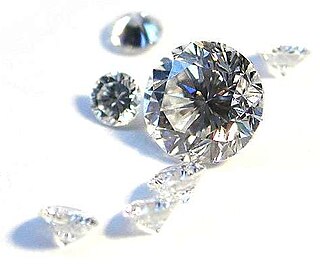
Diamond is one of the best-known and most sought-after gemstones. They have been used as decorative items since ancient times.
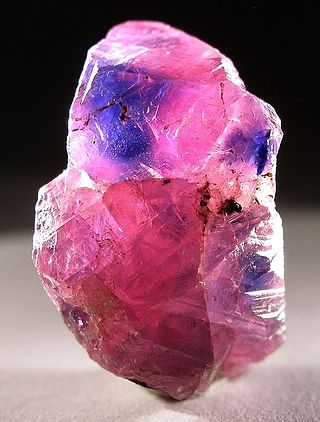
Gemstones have been found in Greenland, including diamond, ruby, sapphire, kornerupine, tugtupite, lapis lazuli, amazonite, peridot, quartz, spinel, topaz, and tourmaline. Most of Greenland's ruby and sapphire occurrences are located near the village of Fiskenaesset/Qeqertarsuatsiaat on the southwest coast.

Yogo sapphires are blue sapphires, a colored variety of corundum, found in Montana, primarily in Yogo Gulch in Judith Basin County, Montana. Yogo sapphires are typically cornflower blue, a result of trace amounts of iron and titanium. They have high uniform clarity and maintain their brilliance under artificial light. Because Yogo sapphires occur within a vertically dipping resistive igneous dike, mining efforts have been sporadic and rarely profitable. It is estimated that at least 28 million carats of Yogo sapphires are still in the ground. Jewelry containing Yogo sapphires was given to First Ladies Florence Harding and Bess Truman; in addition, many gems were sold in Europe, though promoters' claims that Yogo sapphires are in the crown jewels of England or the engagement ring of Princess Diana are dubious. Today, several Yogo sapphires are part of the Smithsonian Institution's gem collection.

There are many types of gemstones of Pakistan. They can be found among the nation's three mountain ranges - the Hindu Kush, the Himalayas, and the Karakoram - in the provinces of Khyber Pakhtunkhwa, Gilgit-Baltistan, Balochistan, and the Federally Administered Tribal Areas. The gemstone industry in Pakistan has the city of Peshawar as its hub, and there are many companies working in it.

The Sunrise Ruby is the world's most expensive ruby, most expensive coloured gemstone, and most expensive gemstone other than a diamond.

Vladyslav Yavorskyy is a gemstone dealer and jeweler based in Bali, Indonesia, United States. He is best known as one of the world's largest dealers and authorities on spinel. He is also the author of at least six gemstone-related books, one of which was named as one of the Best Books for Gem Lovers by JCK magazine in 2016.
The Star of Adam is an oval-shaped blue star sapphire, currently the largest star sapphire in the world. It weighs 1,404.49 carats. Prior to its discovery in 2015, the Black Star of Queensland, weighing 733 carats (146.6 g), was the largest star sapphire gem in the world.
The Allison and Roberto Mignone Halls of Gems and Minerals are a series of exhibition halls at the American Museum of Natural History on the Upper West Side in Manhattan, New York City. The halls opened on June 12, 2021, as a complete redesign of their predecessors, the Harry Frank Guggenheim Hall of Gems and Minerals and Morgan Memorial Hall of Gems. The halls feature thousands of rare gems, mineral specimens and pieces of jewelry.